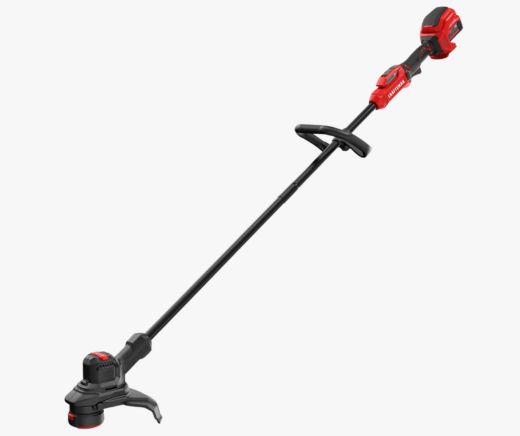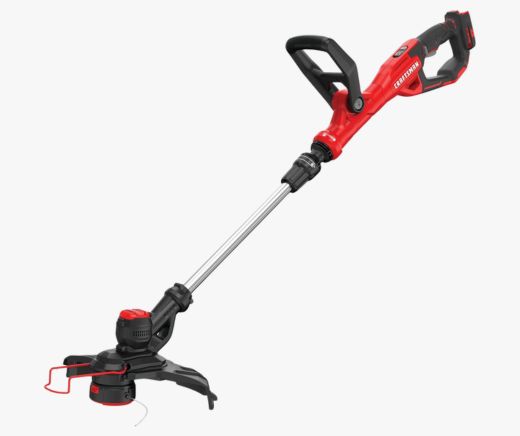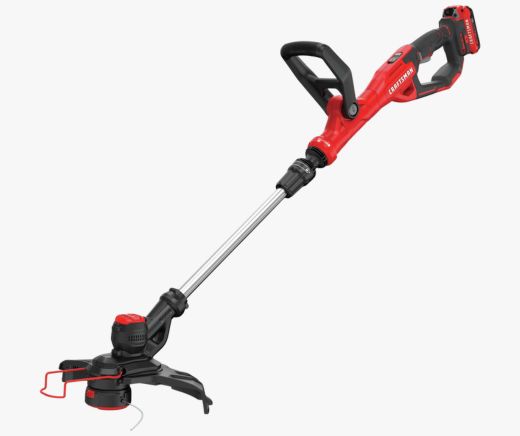Your Craftsman weed eater won’t start. You pull the cord again and again—but nothing. I’ve been there. Standing in the sun, hot and annoyed, wondering what went wrong.
Most of the time, it’s something small. Maybe old gas. Maybe a clogged filter. Or the engine is just flooded. After years of trial and error, I’ve figured out what works. Let’s walk through the real fixes. I’ll help you save time—and your weekend.

CRAFTSMAN V20 RP Cordless String Trimmer, Brushless, 5.0Ah Battery & Charger Included
Table of Contents
Start with the Basics: Are You Starting It Right?
Before you think something’s broken, check your starting steps. I’ve messed this up more times than I’d like to admit.
Cold Start Sequence for Craftsman Weed Eaters
Most Craftsman weed eaters have a simple startup. But skip a step—or pull too many times on full choke—and it won’t start.
Here’s the cold start routine I follow every time:
- Set the trimmer on flat ground. Make sure the switch is ON.
- Press the primer bulb 8 to 10 times, until it’s mostly full.
- Move the choke to Full (Position 1).
- Hold the throttle and pull the cord 4 to 5 times. Listen for a “pop.”
- Once you hear the pop, move the choke to Half (Position 2).
- Pull again. It should start in 5 to 10 pulls.
- Let it run for 30 seconds. Then switch to Run (Position 3).
Mistakes I Made Early On
I used to leave it on full choke too long. The engine would flood, and I’d smell gas right away. Once I learned to switch the choke at the first “pop,” things got way easier.
In the U.S., many people use their trimmers only in spring or summer. So after winter, this step matters even more. Use fresh gas. Follow the steps exactly. Don’t rush it.

CRAFTSMAN V20 WEEDWACKER Cordless String Trimmer Edger with Automatic Feed, 13 inch, Bare Tool Only
How to Tell If It’s Flooded
Even if you do everything right, it can still flood. It happens a lot—especially after pulling too much on full choke.
Here’s how I know it’s flooded:
- I smell gas around the engine or muffler
- The spark plug looks wet
- It starts to fire, then dies right away
What I Do When It Floods
Here’s my fix:
- I pull out the spark plug and wipe it clean
- I let the engine sit for 10–15 minutes with the plug out
- I move the choke to Run
- Then I pull the cord 5–6 times to clear it out
After that, I reinstall the plug and pull again—with no choke. Most of the time, that gets it going.
Fuel System Fixes (Most Common Culprit)
If your Craftsman weed eater won’t start, the fuel system is often the problem. It’s happened to me more times than I can count—usually after it sat all winter in the garage.

CRAFTSMAN V20 WEEDWACKER String Trimmer & Edger, Cordless
Old or Bad Gas
Why stale gas ruins everything
Gas goes bad fast—faster than I thought. After about 30 days, it starts to break down, especially if it has ethanol. That means poor starts, gummed-up parts, and a lot of pulling with no results.
What Happened to Me: One spring, I used leftover gas from last summer. The engine sputtered, then died—and wouldn’t start again until I drained the tank and added fresh fuel.
My Seasonal Storage Mistake
I used to leave gas in the tank all winter. That gummed up the lines and carb. Now I either run it dry or add a fuel stabilizer before storage. In the U.S., where many trimmers sit for months, this is key—especially if you use E10 fuel.
What I Do Now:
- Use only fresh gas (under 30 days old)
- Buy ethanol-free pre-mix when I can
- Always add a stabilizer to pump gas
Fuel Lines and Filter
Cracked lines and clogged filters
Even with fresh gas, it won’t work if fuel can’t reach the engine. Old lines crack. Filters clog. I once found a cracked line leaking gas before it ever reached the carb.
Quick Checks:
- Squeeze the primer bulb. If it stays flat, there’s a leak.
- Open the gas cap and pull out the filter with clean pliers or a wire. If it’s dirty, swap it.
- Look for cracks near where the lines enter the tank.
Easy Fix:
Fuel line kits are cheap and come with new filters. I always take a photo before removing anything, so I know how to reconnect it. One line pulls fuel in, the other sends it back. Get them wrong, and it won’t run.
Read More: Black and Decker vs WORX Edger
Dirty or Clogged Carburetor
How I cleaned mine—no fancy tools needed
Even with clean gas and working lines, the engine won’t run if the carb is clogged. Mine clogged after one season of sitting.
What I Noticed:
- It started with choke but died once I switched to “Run”
- The primer bulb worked, but fuel wasn’t flowing right
Is It Getting Spark? The Ignition System Check
If your Craftsman weed eater still won’t start—and fuel’s not the issue—it might be the spark. No spark means no ignition. I’ve chased this problem more than once before learning what signs to watch for.

Spark Plug Issues
How to check, clean, and replace
Start with the spark plug. It’s small but important. I always pull it out first when my trimmer won’t run.
Here’s what I check:
- Is the tip black or covered in soot?
- Is it wet with gas? That could mean it’s flooded.
- Is the gap too wide or shut tight?
I use a wire brush to clean the tip. Then I check the gap with a feeler gauge. For most Craftsman models, I aim for a 0.025″ gap. That gives a strong spark.
My Go-To Tip: Forget the gap size? Most spark plug boxes in the U.S. list it. Or match the old one—if it worked before. I keep a spare plug on hand just in case.
If the plug is over a year old or looks worn out, I replace it. They’re cheap and easy to find at any U.S. hardware store.
No Spark? Check the Coil and Kill Switch
A quick kill switch test
Still no spark? It could be the coil or kill switch. I once replaced a good plug—twice—before I found the kill switch was stuck.
Here’s what I do:
- Disconnect the kill switch wire from the coil.
- Pull the cord and check for spark again.
I use an inline spark tester. But if you don’t have one, hold the plug near the engine block and look for spark (just be careful). If spark comes back, the kill switch is likely shorted.
When My Coil Failed Mid-Job
One time I was trimming the yard and it just quit. Wouldn’t start again. No spark at all. The coil had failed. I replaced it, and the engine ran like new.
Coils are not expensive, and YouTube has lots of U.S.-based guides for swapping one out. Total fix time? About 20–30 minutes.
Don’t Overlook Air and Compression
Sometimes you’ve got fuel and spark—but the engine still won’t run. That’s when I check airflow and compression. These are often ignored, but they matter more than you’d think.
Air Filter Clogs
What a dirty filter looks like
A clogged filter chokes your engine. No air, no spark, no start. I once spent an hour pulling the cord—only to find the filter packed with dust and grass.
Here’s what I check:
- The filter looks dark or feels sticky
- It’s soaked with oil or gas
- Grass or dirt is stuck to it
How I Clean It:
- Rinse foam filters in warm, soapy water
- Squeeze out the water
- Let it dry all the way
- Add a drop of filter oil before reinstalling
Paper filters? I don’t clean those. I replace them. They’re cheap and easy to find in most U.S. hardware stores.
Spark Arrestor Blockage
Why it matters—and how I almost missed it
The spark arrestor is a small screen in the muffler. It stops sparks from flying out. Over time, it gets clogged with carbon. I didn’t even know it was there until my trimmer started stalling at full throttle.
What I Noticed:
- It ran fine at idle but bogged down under load
- It didn’t seem like a fuel problem
- The exhaust smelled odd—like burnt oil
What Worked for Me:
I took off the muffler, removed the screen, and burned the gunk off with a propane torch. It glowed red, and the soot flaked off. No torch? A wire brush works too.
Compression Check
A quick way to test engine health
Still no luck? You might have low compression. That means the engine can’t build pressure to ignite fuel. It usually means worn rings or gaskets.
How I Check:
- Take out the spark plug
- Screw in a compression gauge
- Pull the cord 4 or 5 times
A good reading is 90–110 PSI. If it’s much lower, the engine is worn out. At that point, I usually start thinking about a replacement. For most home users, rebuilding just isn’t worth the cost or time.
Fast Troubleshooting Table

When your Craftsman weed eater won’t start, you don’t always need a deep dive. This quick table matches the problem to the fix—fast.
| Symptom | Likely Cause | Fix + Where to Look |
| Primer bulb won’t fill | Cracked fuel line or clogged fuel filter | See 3.2 Fuel Lines and Filter |
| Starts and dies right away | Flooded engine or dirty carburetor | See 2.2 Flooded Engine or 3.3 Dirty Carburetor |
| Won’t start after storage | Old gas or clogged carb | See 3.1 Old Gas and 3.3 Dirty Carburetor |
| Engine turns but no spark | Bad plug or faulty coil or switch | See 4.1 Spark Plug and 4.2 Coil + Kill Switch |
| Runs at idle, bogs under throttle | Dirty air filter or clogged spark arrestor | See 5.1 Air Filter and 5.2 Spark Arrestor |
| Fuel sprays from lines | Cracked return line | See 3.2 Fuel Lines and Filter |
| Pull cord feels too easy | Low engine compression | See 5.3 Compression Check |
| Pull cord is stuck or very hard | Engine seizure or flywheel debris | Not covered here—may need pro repair |
My Personal Fix That Finally Worked
How I got my Craftsman weed eater running again
After weeks of trial and error, I found the fix. It was simple—but I missed it at first.
The plug was fine. The gas was new. But the carb was clogged with old fuel. I removed it, cleaned every hole with carb spray, and replaced a gasket. That was it. It started on the third pull.
The Small Tweak That Changed Everything
The real trick? I followed the choke steps exactly and swapped in a new spark plug. That combo made all the difference.
What I’d Do Differently Next Time
Next time, I won’t wait. I’ll check the air filter, clean the carb, and change the plug at the first sign of trouble. No more guessing.
Honest Advice: Fix or Replace?
If your trimmer is less than five years old, it’s worth fixing. Parts are cheap, and most jobs take under an hour. But if you’ve already replaced the carb, coil, plug, and lines—and it still won’t run—it may be time for a new one.
How to Prevent It from Happening Again
What I do after every season
At the end of fall, I empty the gas tank and run the engine dry. That alone prevents 90% of the problems I’ve had.
Fuel Storage Tips That Work
- Use ethanol-free gas when you can
- Add a fuel stabilizer before winter
- Store gas in a sealed, labeled can
- Keep the can in a cool, dry place—away from the sun
Simple Tune-Up Tricks That Save Me Time
- Replace the spark plug once a year
- Clean or replace the air filter
- Spray carb cleaner through the intake
- Check fuel lines for cracks
Each one costs a few bucks and takes five minutes. But they’ve saved me hours of stress.
Conclusion: Don’t Give Up—Fix It Right the First Time
If your Craftsman weed eater will not start, don’t toss it just yet. Most of the time, it’s an easy fix.
I’ve been through it all—flooded engines, cracked lines, bad plugs, clogged carbs. Once you know what to check, it gets easier.
I’m Here to Help
Got a question? Drop it in the comments. I’ll do my best to help—or someone else might chime in with their fix.
Want to Keep Yours Running?
Here are links to parts and kits I use and trust (for U.S. users):
- Spark plugs
- Fuel line kits
- Carb rebuild kits
- Air filters
Keep them on hand, and you’ll always be ready for next season.
FAQs – Craftsman Weed Eater Will Not Start
Why won’t my Craftsman weed eater start, even after many pulls?
It’s often old gas or a flooded engine. Check your fuel, then follow the right starting steps to fix it fast.
How do I know if the engine is flooded?
It will smell like gas and not run. The spark plug may be wet. Let it sit, clean the plug, and try again with no choke.
Can old gas stop my Craftsman weed eater from starting?
Yes. Bad gas clogs the carb and keeps the engine from firing. Use fuel that’s less than 30 days old.
What should I check on the spark plug?
Look for black soot or wet spots. Clean it with a wire brush. Make sure the gap is around 0.025 inches.

